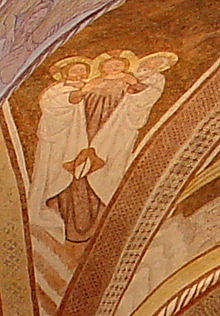Trinity fresco Urschalling
The Trinity fresco Urschalling is located in the St. Jakobus Church in the Upper Bavarian town of Urschalling in Chiemgau . The fresco is part of a figure-rich wall and ceiling painting from the 14th century and fills the lower tip of a vault gusset .
The picture is remarkable for its subject. The holy Trinity is shown - according to Christian teaching, the one God in three persons . The Urschallinger image deviates from the main types of western and eastern Trinity iconography in an original way.
The trinity shows itself in three faces and three upper bodies with (there) two upper and three lower garments. However, towards the bottom where the vault ribs meet, the three bodies merge into one; the two upper garments and the three undergarments of the figures combine to form an upper and an undergarment. The whole group has only two arms. The three halos that surround the heads are not delimited from one another and are braced together by the three beams of a single cross nimbus .
The interpretation of the middle figure is controversial. Between the white-bearded old man on the right (indisputably God the Father) and the brown-bearded man on the left (God the Son), who turn halfway to the center, a round and beardless face with long, light brown hair can be seen as the embodiment of the Holy Spirit looks directly at the viewer. The white upper garment does not cover this figure, only the darker undergarment, which is gathered in folds below the breast.
It is disputed whether this figure is a woman or, within the classic old-man-youth scheme, a very young man. The more recent research in the history of art tends towards the latter interpretation.
Theological interpreters, however, are fascinated by the female features of this figure and see in them a reference to the feminine side of God, which has been repressed in the mainstream of Christian history, and to the Old Testament talk of the Spirit of God ( Hebrew ruach is a feminine). Also at Maria is thought of in the New Testament comes close to the Holy Spirit in a unique way and their shape then here almost verschmölze with the divine spirit. According to Leonardo Boff , sexual symbols (both female and male) can be clearly seen in the lower part of the picture. Other interpreters are at least convinced that an ancient, also Christian, insight into faith is contained in the picture: divine love in person.
The direct identification of the figure with Mary would, however, correspond to the idea of the Trinity, which Islam ascribes to Christians and which is vehemently opposed; a medieval Christian hardly thought so.
literature
- Verena Wodtke-Werner: The Holy Spirit as a female figure in Christian antiquity and the Middle Ages. An examination of texts and images (= Theological Women's Research. Vol. 3). Centaurus-Verlags-Gesellschaft, Pfaffenweiler 1994, ISBN 3-89085-871-6 (also dissertation at the University of Tübingen, 1993).
